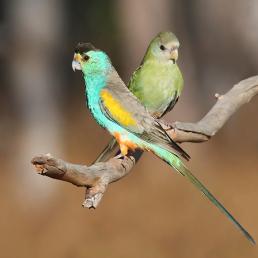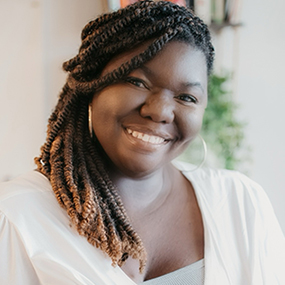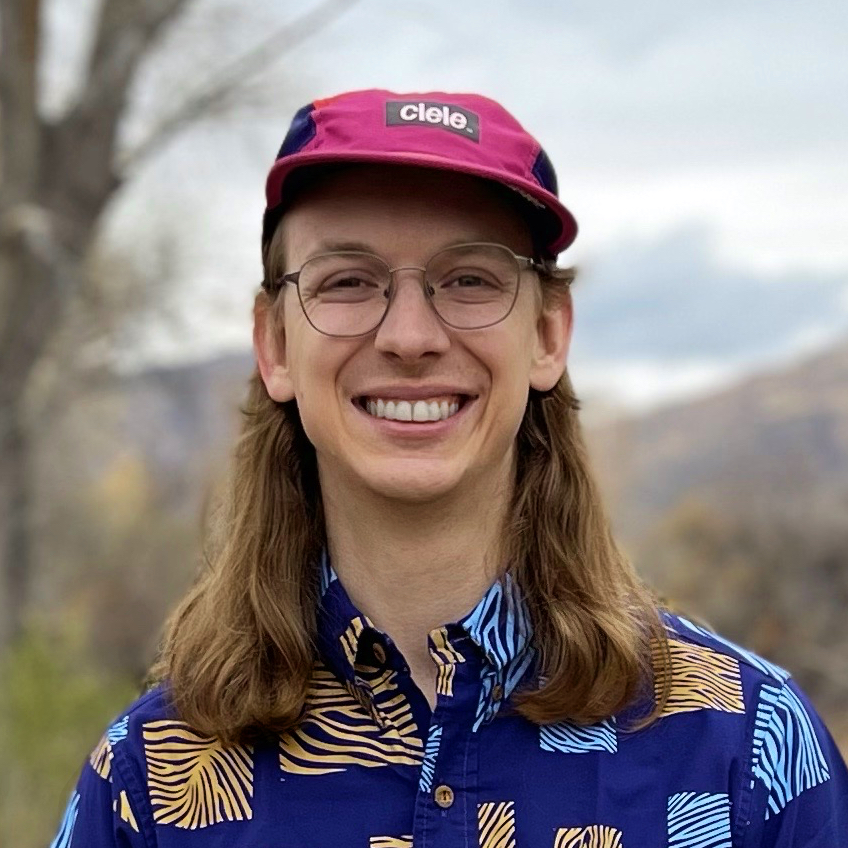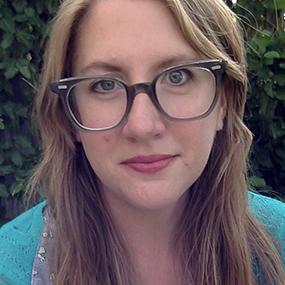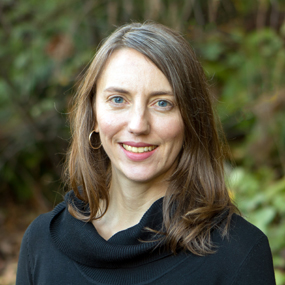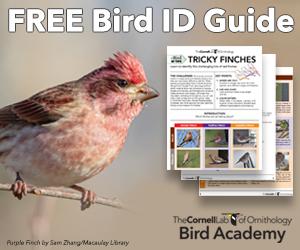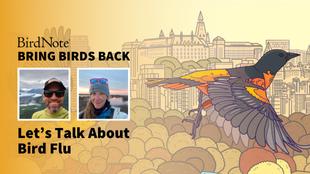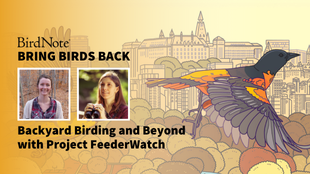

Join BirdNote tomorrow, November 30th!
Illustrator David Sibley and actor H. Jon Benjamin will face off in the bird illustration battle of the century during BirdNote's Year-end Celebration and Auction!
Host Tenijah Hamilton hears firsthand from coffee grower Oswaldo Acevedo in Colombia how shade-grown coffee farms offer better wildlife habitat and working conditions than most industrial coffee plantations. She speaks to Ruth Bennett and Justine Bowe from the Smithsonian Institute Migratory Bird Center about the science behind the Bird Friendly Coffee certification, how bird friendly coffee growers benefit birds and other wildlife, how to find bird friendly coffee near you, and the goal to have a whole range of certified bird friendly products on the shelves in the future.
Tenijah Hamilton: BirdNote Presents.
Tenijah Hamilton: [yawn] Good morning. This is Bring Birds Back, I'm your host, Tenijah Hamilton. And uh ... I’m tired.
[Music, Sound of getting bags of coffee]
For today’s show, we're looking at our morning cup o’ joe — how our coffee impacts birds. I'm trading in the usual Folgers in my cup for certified Bird Friendly Coffee.
Tenijah Hamilton: Alright, our first sip. [sips] Mmm. That is the stuff. So good.
This coffee is from Café Mesa de los Santos in Colombia. The plantation — coffee farms are often called plantations, a holdover from the days of European colonization — is run by Oswaldo Acevedo, and they’ve been growing coffee for a long time.
Oswaldo Acevedo: In our family, I'm the fifth generation of coffee growers. So we've been working in coffee since 1871.
Tenijah Hamilton: Wow.
Oswaldo Acevedo: So there is a lot of tradition in this thing, and now I'm about to pass to my son.
Tenijah Hamilton: That's such an incredible legacy to carry on. And I love that you're saying that you're going to pass it on to your son.
Oswaldo Acevedo: Well, that's what I want. I'm not sure what he wants.
Tenijah Hamilton: So I'm curious, because you mentioned that this farm has been in the family for a good long time. This is a fifth generation farm. Has this always been a bird friendly farm or has that changed over the past couple of years?
Oswaldo Acevedo: Well initially, farms in our country used to be a multi-purpose farm. So they would, they had cattle, they had sugarcane and they had cocoa and they had coffee. Those were the four most common agricultural production in the farms. What I did in 1996 when I took over was to convert all to coffee. So right now all the area is planted in coffee, and all the area is planted with shade trees.
[music]
Tenijah Hamilton: And those shade trees are what’s so special about farms like Oswaldo’s. Growing coffee organically in full-shade is actually a more traditional practice — we’ll get more into that in a bit — and it has a lot of benefits.
Many coffee aficionados say it produces more complex flavors. I’m no expert, but I enjoyed the natural sweetness in the coffee from Oswaldo’s farm. It was just really smooth, and as somebody who swears by instant coffee, it couldn’t have been more of a night-and-day experience.
But we’re not talking about this coffee on Bring Birds Back just because it tastes good. We’re talking about it because the thick, multi-level tree canopies of these farms provide incredible habitat for migratory birds. Habitat loss is a huge issue for birds that migrate to Central and South America, so farms like Oswaldo’s really matter. And clearly the folks at Café Mesa de los Santos have cultivated a great winter retreat for them. Oswaldo told me that they've seen at least 162 different bird species on the farm since they started paying attention to the birds in the 90s.
I asked Oswaldo to paint a picture of what it’s like on his farm, and I have to say, it sounds pretty amazing ... as long as you’re an early riser.
Oswaldo Acevedo: When you are on a bird-friendly farm, you don't sleep after 6:00 AM.
The noise is totally different than outside in the sun, because of all the animals producing their songs or their noises in the forest.
When you walk into the coffee farm, immediately, you walk into the forest. You feel the change in temperature. It could be five or six degrees if you are in the sunshine or you are inside the forest.
Tenijah Hamilton: It can be six degrees Celsius, or 11 degrees Fahrenheit, cooler in the shaded forest than under the blazing sun. For example, if it were 86 degrees Fahrenheit in the sun, which is a bit too hot for my taste personally, it might be a sweet 75 degrees Fahrenheit in the shade, which is my kind of weather. That's especially meaningful for farmers like Oswaldo, working in much nicer conditions than on an industrialized full-sun farm. And the shade isn’t the only benefit to the farmers — the birds help out, too.
Oswaldo Acevedo: The main thing for us is that they are insect controllers. So birds are good at controlling the populations that can harm the coffee. So that way we don't have to use chemicals to spray in the plantation because birds take care of that. For instance, at this time of the year, summertime, there is a big abundance of worms and many insects. So you can see birds taking care of those worms because they are very delicious for birds.
Tenijah Hamilton: How does it feel to see birds on your coffee plantation, knowing that you're giving them a safe place and a place for refuge?
Oswaldo Acevedo: You know, that means happiness. Everybody's happy with the birds. Very, very happy.
Tenijah Hamilton: Even with the 6:00 AM wake up call?
Oswaldo Acevedo: Yeah, young people like to sleep late, but once you reach a certain age, it's impossible.
Tenijah Hamilton: Thank you so much, Oswaldo. This has been really great.
Oswaldo Acevedo: My pleasure. Thank you.
Tenijah Hamilton: Oswaldo’s farm is not the only place growing coffee in a way that helps birds. In fact, the Smithsonian Institute's Migratory Bird Center runs a Bird Friendly Coffee program, which helps farmers make their plantations better for birds and wildlife, and certifies the coffee so consumers know their money is supporting this work.
I’m joined by two of the folks from the Smithsonian. Justine Bowe manages the Bird Friendly certification program. How’re you doing Justine?
Justine Bowe: Doing great!
Tenijah Hamilton: And Ruth Bennett is a research ecologist, she's the scientist on the bird-friendly coffee team developing the standards and investigating how birds do in these different types of agricultural landscapes. Hi Ruth, how’re you?
Ruth Bennett: Doing well, thanks so much for having us.
Tenijah Hamilton: It’s great to have you on the show! So, to start at the beginning — how did this idea of bird friendly coffee come about?
Ruth Bennett: Yeah. So bird friendly coffee as a concept came about in the mid 1990s. Scientists and birdwatchers were really starting to notice the declines in North American migratory species that overwinter in Central and South America. So there was a lot of concern about what was happening to these migratory birds, and very little was known about where they spent six, seven months of their life cycle. And some Smithsonian scientists that did a lot of work in Mexico and Peru noticed that in shaded coffee plantations, there seemed to be way more migratory birds than any other habitat type in Central and South America.
So Russ Greenberg was the scientist that started this all. He kept very detailed notes of birds on coffee and cacao plantations in Mexico. And then expanded that to Peru and found that, indeed, the diversity of migratory birds and the abundance was higher in these shaded coffee and cocoa farms than it was in nearby forests or any other sort of human dominated landscape, like cattle pasture or urban environments. So based on those findings, he launched the Bird Friendly Coffee certification to incentivize farmers, and also link with birdwatchers in North America to purchase coffee that was grown on plantations that supported migratory birds.
Justine Bowe: I'd like to add to that also and just to say that bird friendly coffee, it's grown in this really rich biodiverse shade, but that is not a Smithsonian invention at all, or due to any observations by scientists coming and visiting farms. That's actually more the traditional way for coffee to be grown. It evolved in the shade in Ethiopia growing in the wild to then being brought to the New World and cultivated under shade. And it wasn't until the 1970s or so when farms started to clear cut forest in order to grow coffee and to grow more coffee in order to increase incomes. So this is more a return or a celebration of that traditional cultivation method.
Tenijah Hamilton: Thank you for that additional context, Justine. That is really helpful. And it actually brings me to my next question — what is it about this traditional way of growing coffee that's friendly to our lil' bird buddies? You know, I think it's pretty easy to understand how keeping a cat inside means it’ll kill fewer birds, or planting native plants even, I can see that the birds are coming to my yard. With the coffee I buy at the store, it's a little more abstract on how this can help birds. You referenced the shade and the biodiversity it fosters — but how exactly does this help birds?
Ruth Bennett: So I think most people that drink coffee don't have a strong relationship with the areas that coffee is grown. We don't grow coffee in North America, so most people don't have a chance to go out and walk around on a coffee farm and see what it looks like. But there's two primary ways in which coffee is grown today. One, we call full sun monoculture. That's an industrialized form of coffee production, similar to a wheat field or a corn field where there are no associated plants. It’s only the coffee. There's no tree species. It's grown with a full agro-chemical regime, pesticides, fertilizers, herbicides, insecticides. And the goal is to maximize the amount of coffee you produce on the smallest land possible. So that's how most coffee is produced today. There are very few birds, insects, wildlife that can live in that type of cultivation system.
In contrast, a bird friendly coffee farm has multiple species of shade trees and the coffee is planted underneath them. So you do produce a little bit less coffee on the same area of land, but it provides a space for, often, monkeys, sloths, lots of butterfly species. Tons of different bird species in addition to the migratory bird species that we're so concerned about. And currently, the Smithsonian Bird Friendly label is the only label on the market that indicates 100% of your coffee came from a plantation that supported migratory songbirds and other wildlife.
Tenijah Hamilton: So I talked to a bird-friendly coffee farmer earlier, his name is Oswaldo, and he mentioned how this can be a symbiotic relationship, with birds also helping out the farmers — can you tell me more about that?
Ruth Bennett: Yeah, absolutely. There's been quite a lot of research about how birds control insect pests of coffee itself. In Latin America, the coffee berry borer beetle is a common pest. It can really reduce production. And migratory birds specifically, if they're on the plantation, they eat up to 50% of those coffee berry borer beetles before they actually attack the coffee grain. So that can save farmers a lot of money, thousands of dollars per year, that they would either lose in production or need to invert in pesticides to control that. Also when you have a shaded plantation, you don't need to spend as much money on fertilizers, pesticides, insecticides, because you have this functioning ecosystem. And that creates an environment that's ultimately healthier for the coffee farmers as well. So the birds are really giving something back to the farmers when the farmers leave a space for them.
Tenijah Hamilton: That's awesome. So, what are the requirements for Bird Friendly certification? I mean, what is needed to get that label on a bag of beans, and how did you decide on those criteria?
Ruth Bennett: So Smithsonian Migratory Bird Center is primarily a research organization. So the certification was rooted first in science about what types of habitat features provide high quality habitat to migratory birds. And with that work, we found that the number of shade trees, the diversity of those shade trees, and the vertical structural diversity — so how complicated the vegetation and how many unique types of vegetation exist on the coffee farm — all of those things are strongly correlated with the number of bird species and the abundance of birds that will live on that coffee farm. So our standard reflects that original research that was done.
And then there was a second level of research with coffee farmers and coffee industry groups to verify whether or not our standards would work for coffee production. We weren't interested in creating a standard that was so strict that no farmer could make a living income if they farmed according to our standard. So there was a negotiation period that happened in the late nineties, between a lot of different coffee institutions, where we received feedback about what percentage of shade could be planted above coffee and still have a viable coffee crop come out of it. So our standard is really a fusion between what's best for birds and what farmers are able to do and still produce coffee.
Tenijah Hamilton: Does it allow for farmers to charge more for their crop? The fact that they have this Bird Friendly certification?
Justine Bowe: Sure. Farmers can negotiate a premium with their buyers. We don't set that price, so it ranges. Anecdotally, what we hear is anywhere from three to five to 10 cents more per pound for Bird Friendly coffee, even going up to 25 cents a pound for the right buyer — Japan. So yeah, there are some big Bird Friendly fans in Japan, which is pretty neat.
Tenijah Hamilton: Interesting. Um, now that we've kind of pivoted to talking a little bit about farmers, I'm really curious about — how do farmers find you? And are there outreach efforts that you all undertake to kind of invite them to the table?
Justine Bowe: Farmers who have really great shade on their farm and who grow organic certified coffee can become Bird Friendly certified. They just request an audit from our Bird Friendly certifiers. And these are third-party professional auditors that we've trained who are actually out in the field visiting farms, talking with farm owners, and helping them make decisions about how to certify or not certify their crops. So those certifiers are often already there in organic farms and they're aware of us, they're aware of what bird friendly habitat looks like and what it does. And oftentimes we'll discuss that as an opportunity or a possibility with those farmers.
Ruth Bennett: I would say the certification is not, right out of the bag, accessible to all farmers, because we do require this third party audit. That's something that tends to be very expensive for a single farm that's not part of a larger cooperative. So most of the groups we certify are either already organized in farmer cooperatives, or they’re large estate farms.
Tenijah Hamilton: Yeah, I'm very interested in that accessibility piece. And I'm curious for farmers who may not have those means, but who are interested in conservation and who are interested in making their farm habitable for these birds, what does that process look like for them? Are there efforts underway to help?
Ruth Bennett: Yeah, we know that several parts of our certification do function as barriers to entry for smallholder farmers, and we have a research program underway right now to understand what the inherent costs of our certification are and find ways to limit those or offset those costs for farmers that would like to receive the certification. So there's many different ways that that can happen. A roaster that purchases the coffee can choose to fund Bird Friendly certification for farmers. Because the roaster is the one that has the consumer base that's receiving that higher price for coffee when they tell the Bird Friendly story about it. And we're looking for alternative verification schemes as well that are less costly and less time intensive than our current audit. But this is all research that's ongoing, so stay tuned in the future to see how we implement some of these changes that we would like to do.
Tenijah Hamilton: After the break, we'll talk about how to get some of this delicious shade-grown coffee, how to make it accessible, and how to make everything bird-friendly. That's after this.
AD BREAK
Tenijah Hamilton: This is Bring Birds Back. I’m Tenijah Hamilton. And I’m talking with Justine Bowe and Ruth Bennett, who work on the Bird Friendly Coffee program at the Smithsonian Institute’s Migratory Bird Center. So I got my coffee from Oswaldo's Café Mesa de los Santos, but looking around near me I was having trouble finding where to buy certified Bird Friendly Coffee. I know I can buy it online and you have a really nice store finder on your website so people can find the nearest retailers, but it was definitely, you know, requiring some more planning. How can Bird Friendly Coffee grow and become less of a niche offering?
Justine Bowe: Sure. We are growing and sales over the past five years continue to double. So that's the good news. The bad news is that it's true, it can be tough to find. There are a few national chains that do carry it. You can find Bird Friendly certified coffee at all Whole Foods. You can find it at Peet’s Coffee and Tea.
The other issue is that we need to raise awareness for Bird Friendly certification and for this concept of doing better by biodiversity in the way that we grow food. So what we do recommend to people is that, you know, as Ruth mentions, it doesn't happen unless there's the demand from the actual end user, from the coffee drinker, from the consumer. You need to talk to your local grocer. You need to say, “I want a bird-friendly coffee available here. Here's where you find it: Drinkbirdfriendlycoffee.com.” And it's really that simple. People are willing to pay a lot more for it. So it's over a dollar per cup, and it's over $3 per pound of coffee. And that's really a lot of value. But again, that really important kind of transformational factor is people have to learn about it. People have to talk about it. We need a critical mass of people who are asking for Bird Friendly Coffee in order for stores to offer it in more regions.
Tenijah Hamilton: And it seems really important to also draw attention to, and this is something we mentioned earlier: you're getting better quality, you're doing better for the environment. So it's kind of, when you look at it in totality, it might take a little more work to source, but it seems very much worth it.
Justine Bowe: That's what we are standing behind. Certainly from a quality perspective, we are super happy with the quality of Bird Friendly Coffee. You know, you get what you pay for, and that's not just in the coffee bean, but that's also in the quality of the habitat that’s there.
Tenijah Hamilton: So I’d like to go back to the idea about lowering barriers to entry — and not just in the certification process, but for coffee drinkers, too. If I don't have Bird Friendly Coffee available to me, is drinking organic coffee better than a coffee with no certifications?
Ruth Bennett: Yeah, absolutely. So everybody working in this space likes to say, “Don't let perfect be the enemy of the good. Don't let the fact that you can't find bird friendly coffee at your grocery store limit you from buying coffee that's better for birds.”
So we would say that organic is probably the second best thing you can look for. It's very difficult to cultivate coffee organically with no shade at all. So organic plantations are very likely highly-shaded plantations that are providing good quality habitat for birds. Maybe not up to Bird Friendly standards, but certainly better than a full sun, highly-technified monoculture.
There's other certifications as well that do a little bit to ensure that plantations have some habitat, or that a portion of their supply comes from shaded plantations. So you can look for Rainforest Alliance certification. They don't guarantee that coffee comes from shaded plantations, but certainly a portion of their supply does. So it's better than a coffee with no certification at all. And you can also look for Fair Trade certification, which ensures that workers are part of the negotiation for price, and that some of the higher price premium comes back to the community and is invested in infrastructure, education. So Fair Trade certification, while it's not specifically targeting the environment, certainly has better benefits for coffee communities. So I would say any certification is better than a coffee with no certification, and buy organic if you can.
Tenijah Hamilton: Alright, so I want to talk a little about what's happening beyond coffee — Ruth, I know you're working on expanding out to a new crop that will be coming soon to a chocolate bar near you. Tell me more about this and where you envision the Bird Friendly program going.
Ruth Bennett: Yeah. We envision a future in which all crops can be grown in bird friendly ways where their production doesn't actively reduce bird populations. And one of the natural expansions for us is cocoa. So cocoa is also grown in the tropics in many of the same countries where coffee is grown, but it's grown at lower elevations. So in order to develop a Bird Friendly cocoa standard, we didn't just want to take exactly what we had for coffee and apply it to this lower elevation zone, because we weren't sure that birds would respond the same way. We weren't sure that shaded cocoa plantations would also be full of migratory birds. So we conducted a full-year review, pulling together all of the published literature about how birds respond to cocoa agriculture. So we used that review, created a standard just like we did for coffee, and it's going through a standard revision process right now. And we're piloting the standard in the Dominican Republic on a reserve called Zuora Zoll reserve. It has one of the greatest remaining tracts of mid-elevation and low-elevation primary forest in the Dominican Republic. It's where basically all female Bicknell’s Thrush overwinter, and there's cocoa grown all around it. So that's where we're piloting the standard. Those farms are undergoing their certification process right now. And Bird Friendly Chocolate should be available in the next four to five months.
Tenijah Hamilton: So exciting. I feel— I definitely would like to be a tester there. Just send it my way.
Ruth Bennett: We will definitely send you some!
Tenijah Hamilton: So that's cocoa. What is next? You mentioned that your hope is that we can kind of move toward that for all crops more sustainably. So what's next after cocoa?
Justine Bowe: So we've been thinking about this, and, you know, there are lots of other products out there that people consume. And there are also lots of other initiatives that are working for bird-friendly solutions of one product or one sector or another. So we've actually started to organize and collaborate with these initiatives in an effort that we're calling the Bird Friendly Coalition.
The coalition right now currently comprises over 50 initiatives representing everything from bird friendly buildings and architectural design to bird friendly rice, maple syrup, beef, mate even, yerba mate. Um, so really we think that there is no shortage of creative bird friendly solutions. And what the Smithsonian hopes to do is to share our knowledge of 20-plus years in creating a market for bird friendly products and also to help guide these initiatives when it comes to setting standards and understanding and solidifying the scientifibase fc or any industry that is looking to perform better for biodiversity and for birds specifically.
Ruth Bennett: Yeah. We have found in reaching out to all of these different initiatives that call themselves bird-friendly, or have standards that are bird-friendlier for production, that all initiatives basically struggle with the same challenges. We, as scientists, our specialty is figuring out what's best for birds. That's not the challenge for us. Figuring out how to give producers incentives that work for them actually to retain those practices, or start doing practices that are bird friendly that they haven't done in the past — that's the challenge. So as a group, we're trying to think collectively about how to market to a bigger audience. How do we get all birdwatchers on board with purchasing bird-friendly products? How do we make bird-friendly products something that are relevant to consumers that aren't birdwatchers but maybe love wildlife? How do we make bird friendly products relevant to people that don't ever think about birds? So those are the questions that we're thinking about with the bird friendly coalition, because we know if there's no consumer demand for bird friendly practices, it's very difficult to provide incentives for producers to engage in bird-friendly types of cultivation or building.
Tenijah Hamilton: Well, now our listeners know! Spread the word, go get some bird-friendly coffee! Justine and Ruth, thank you so much for being here.
Justine Bowe: Yeah, thank you so much!
Ruth Bennett: Thanks for having us.
Tenijah Hamilton: I want to leave you with something that Oswaldo said to me at the end of our conversation.
Oswaldo Acevedo: The next time you buy coffee, please consider nature. Hopefully consumers everyday are going to be more aware and willing to support bird-friendly coffee, because that is going to really make a change in nature. Especially these days that we need it the most.
Tenijah Hamilton: You can find links to the Smithsonian's bird-friendly coffee finder in the show notes and on our website, BirdNote.org. Check it out, find your nearest retailer — and if you don't have anyone selling Bird Friendly Coffee near you, talk to your local coffee shop! Spread the good bird-friendly word. Even if we're not able to see the impact that these coffee farms have, we can help our feathered friends one cup at a time.
Bring Birds Back is produced by Mark Bramhill and me, Tenijah Hamilton. We're edited by Oluwakemi Aladesuyi of Rough Cut Collective. Our content director is Allison Wilson. Our lead science advisor is Trina Bayard. Music is by Cosmo Sheldrake and Blue Dot Sessions.
And thanks to our season sponsor, the Cornell Lab of Ornithology. Check out all they have to offer, like Bird Academy online courses and the Merlin ID app, at AllAboutBirds.org.
Thanks for listening! And tune in next time for our season finale, where BirdNote goes to the beach. See ya then.
Bring Birds Back is sponsored by the Cornell Lab of Ornithology.
About guest Ruth Bennett:
Ruth Bennett is a research ecologist at the Smithsonian Migratory Bird Center. Her research focuses on optimizing the conservation of birds and other wildlife in working landscapes, especially coffee and cocoa growing regions of Latin America. As part of the interdisciplinary Bird Friendly team, Bennett is working to build a Bird Friendly standard that applies to multiple crop types and provides conservation outcomes at both farm and landscape scales. She recently helped launch a Bird Friendly Coalition to bring together market-based conservation initiatives across the hemisphere. Bennett developed a love of migratory birds and coffee agriculture while serving as a Peace Corps volunteer in Honduras. While there, she found a population of overwintering female golden-winged warblers that she studied for a M.S. in applied ecology at Michigan Technological University in 2012 and a Ph.D. in applied ecology from Cornell University in 2018.
Justine Bowe is responsible for managing and growing the Smithsonian Migratory Bird Center’s Bird Friendly Coffee program. She aims to rally awareness for the Bird Friendly® certification and the conservation work it supports, hone the program’s strategy and expand Bird Friendly® protected habitat worldwide. Bowe coordinates a variety of program-related work, including public engagement events,marketing the Bird Friendly® gold standard and managing agreements with roasters. She is also responsible for creating and implementing initiatives, such as Bird Friendly Cities and Taking Flight, programs she hopes to expand to more farmers, roasters and retailers as demand for Bird Friendly® coffees increases. Bowe worked with the Bird Friendly® Coffee program on a contract basis for two years before becoming the program manager. Prior to this, she worked as a freelance marketer for various startup companies, while touring the country as a musician. Bowe began birding at an early age, as the youngest in a family obsessed with and inspired by natural history and conservation. Her education at Tufts University helped to hone her communication and critical thinking skills, and she is always striving to consider the bigger picture of her work for the program in a global context.
